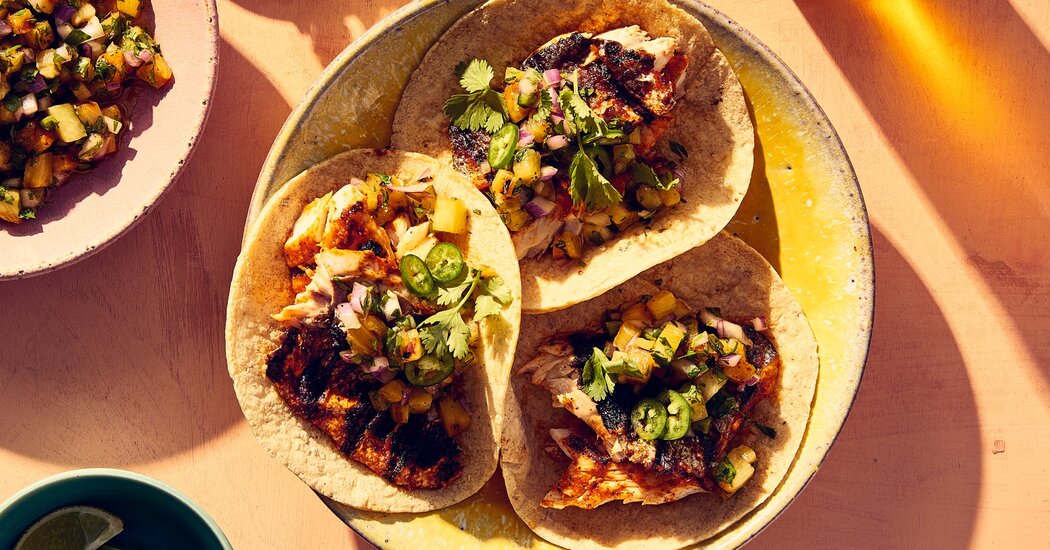
When Luis Herrera is cooking, Korean gochugaru, Thai curry paste and Venezuelan ají dulce make their way into his pots and pans. They appear as often as guajillo and ancho chiles and fresh masa milled down the block from his Mexican restaurant, Ensenada, in Williamsburg, Brooklyn. Inspired by the compatibility of various cuisines, the Venezuelan chef finds moments of ingenuity every day, pulling especially from Latin American influences. “I think that’s when greatness happens,” he says.
Recipe: Fish Tacos al Pastor
After culinary school in Caracas, Herrera worked at restaurants such as Alto in Venezuela and Cosme in Manhattan. Then, last year, he opened Ensenada, where one peek inside the compact but efficient kitchen’s fridge reveals the technicolor components that make up his food. Each salsa, marinade and pickle has its own pint container, the cook’s cabinet of potions ready at his disposal. In my favorite of his creations — this taco de pescado al pastor — he combines four ready-made elements: marinated fish, pineapple pico de gallo, fresh corn tortillas and, what really anchors the dish, an adobo sauce, brick-red and richly layered with chiles.
‘If the chiles in this recipe are the fire, then the pineapple is the ice.’
Adobo means marinade. And in Herrera’s recipe, it will occupy most of your time, but the return on investment couldn’t be higher. The resulting mixture gives a warmth and complexity — a “Hmm, what is that?” — to an otherwise breezy al pastor. Adobo is also a key building block of Mexican cuisine, of which Herrera considers himself a forever student, tasting as much as he can wherever he goes and wherever he cooks, and always, he says, respectfully learning.
If the chiles in this recipe are the fire, then the pineapple is the ice. When he first opened Ensenada, Herrera used pale out-of-season tomatoes that diluted the bright coastal flavors he wanted to showcase in these fish tacos. So he replaced them with diced pineapple and never looked back.
But it’s not just the pineapple that makes this fish al pastor — it’s the char. Al pastor, “in the style of a shepherd,” is a method of barbecuing meat on a rotating vertical spit that Lebanese immigrants brought to Mexico in the late 19th century. Traditionally, a whole peeled pineapple might rest atop layers of pork, like a golden crown that becomes more burnished with every turn of the spit, dripping its golden juices onto the meat. You might not have a rotating vertical spit, called a trompo, in your backyard, but the blazing heat of a grill, coupled with the tongue-prickling heat of the spicy adobo, yields great flavor and honors the source material (the meat).
This al pastor recipe is very versatile in that way. You can make the adobo and the pineapple pico de gallo ahead of time, then use them on different proteins or vegetables throughout the week. “So you can do chicken, you can do pork, you can do carrots,” Herrera says.
At Ensenada, named, in part, for a port city in Baja California, he serves a butterflied fish al pastor, befitting the “mariscos y mezcales” theme, with tortillas so diners can assemble their own tacos. But, for simplicity, he suggests home cooks use boneless fish fillets. Any meaty whitefish will do, but sturdy, buttery swordfish, snapper and branzino are my favorites, especially once kissed by the fire. In fact, everything that goes into this taco can be fire-kissed at one point or another, even the tortillas.
There’s nothing like a good corn tortilla, just warmed through so it slackens and steams. If you don’t have a molino milling fresh masa down the block from you, as Herrera does, then store-bought tortillas are fine. What you can’t buy at the store is the ceremony of making these fish tacos. Invite your neighbors over for a backyard feast, complete with grilled corn and a cooler of iced lagers to go with the sunshine and tacos. Or keep the components in the fridge for yourself: If ever you’re alone in the middle of the night, in need of a quick snack, a midnight taco is the greatest expression of leftovers.



